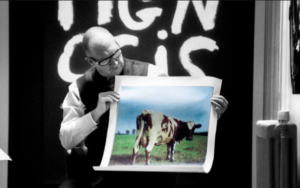SQUARING THE CIRCLE: THE STORY OF HIPGNOSIS: 3 ½ STARS. “lens of fascinating excess.”
 Storm Thorgerson and Aubrey “Po” Powell created some of the most famous images of the 1960s and ‘70s. Under their design company name Hipgnosis, they created album covers that often garnered as much attention as the music on the LPs.
Storm Thorgerson and Aubrey “Po” Powell created some of the most famous images of the 1960s and ‘70s. Under their design company name Hipgnosis, they created album covers that often garnered as much attention as the music on the LPs.
“Squaring the Circle (The Story of Hipgnosis),” a new documentary, directed by legendary photographer Anton Corbijn, and now playing In theatres, reveals the secret sauce that went into making classic covers like Pink Floyd’s “Dark Side of the Moon” and “Wish You Were Here,” Paul McCartney and Wings’ “Band on the Run” and Led Zeppelin’s “Houses of the Holy.”
Told first-hand by Powell, who describes the relationship with his late, prickly partner Thorgerson with great detail and love, the story begins in the late Sixties in the Cambridge, England art scene, and a friendship with the band Pink Floyd.
Falling into a career as a photographer, Powell took the cover photos for Floyd’s second album “Saucerful of Secrets,” while Thorgerson created the wild psychedelic images that framed the band’s pictures. The success of that collaboration led to the creation of Hipgnosis, a company name created as a portmanteau of “hip” for their new and cool approach, and “gnostic,” meaning “wise.”
Using new interviews with Peter Gabriel, Paul McCartney, Jimmy Page, Robert Plant, Noel Gallagher, David Gilmour and Roger Waters, combined with archival footage and interviews, Corbijn goes behind the scenes to reveal the fiery personalities and off-kilter creative process that made Hipgnosis so unique.
The creative inspiration seems to have sparked by the chalk and cheese relationship between Thorgerson and Powell. Powell admits upfront that he was almost as interested in the money as he was the art—“I just wanted to make money and be successful and do the things I wanted to do,” he says.—whereas Thorgerson was a spendthrift, who never let a budget get in the way of a good idea. That push and pull ultimately blew their relationship and company apart, but until punk rock came along, and their extravagantly art designed covers went out of style, the pair, despite their differences, created magic.
Along the way are great stories about how the giant, inflatable pig featured on the cover of Pink Floyd’s “Animals” album, drifted away from the shoot and landed in a farmer’s field, and how Thorgerson once offered Led Zeppelin a cover idea originally designed for Judas Priest. Then there is the story of “Wish You Were Here’s” burning man cover and the Wings Greatest Hits compilation cover, a photo of a small statue shot on location on a snow covered mountaintop in the Swiss Alps. “There was a lot of that in those days,” says McCartney, referring to the cover’s ridiculous cost. “We loved it. It looked great, but then someone said, ‘You could have just gone in a studio in London, and just got a big pile of salt and stuck the statue on top of it. But, you know, that’s just too easy.”
In the end it was changing tastes and shrinking record company budgets that brought the Hipgnosis era to a close, but, as one expert says, until that moment, they were a “lens of fascinating excess.”
Corbijn’s doc is straightforward, austere almost, with little of the wild excess or off-the-hook imagination that typified the work of its subject, but “Squaring the Circle” does do a great job of placing the album artwork in context of its time and timelessness. “There’s a great quote from someone,” says Gallagher, “’Vinyl is like the poor man’s art collection. The posh people have the art on the wall. Working class people have art on the floor, stacked against the wall.’”
